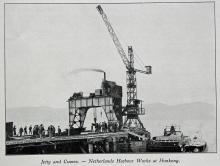This company performed several large dredging and reclamation projects around Asia. A list of their projects from 1912 - 1934 includes three projects in Hong Kong:
- 1924-26: Reclamation off North Point
- 1927-29: Dredging the harbour and reclamation at Kai Tak
- 1932-34: ????
Based on that list, I've set 1924 as the year the company was created in Hong Kong. However it doesn't appear in the Jurors Lists until the list for 1926, which shows 19 employees of the company.
There must have been other projects after 1934, as the 1941 Jurors List still shows three employees of the company.
The only entry for the company in ICRIS shows them registering a non-Hong Kong Company on 13-Feb 1946. I assume this is when they set up business again after WW2. It also gives their Dutch name, NEDERLANDSCHE MAATSCHAPPIJ VOOR HAVENWERKEN N.V. In 1952 they add "Royal" to the front of their company name (and add KONINKLIJKE to the front of their Dutch name.)
They "cease Place of Business in Hong Kong" on 11th Dec 1957.



Comments
Netherlands Harbour Works Company
According to the memoirs of John Pownall Reeves, the British consul in wartime Macau, the Netherlands Harbour Works Company was based in Macau during the war years, where it had HK$3,000,000 in construction equipment, including dredgers, lighters, hoppers, locomotives, and railcars. A Mr. Van Woerkom or Woerkamp served as the manager. The Japanese got one of the dredgers, but the rest of the gear apparently rode out the war in Macau. (The Lone Flag: Memoir of the British Consul in Macao during World War II from HKU Press)
Macau
Thanks Steve, that's a good addition. Looking at the list mentioned above, the company had a major project in Macau in the years 1922-27. A map on that same page shows the outline of the reclamation - a large area of new land.
There were also members of the company in Hong Kong through the war years: of the three men listed in the 1941 Jurors List, I see Rudolf Van Rossum ended up interned at Stanley Camp.
I'm not sure if the company had maintained offices in both cities throughout the 1930s, or if the valuable equipment in Macau you described was transferred there from Hong Kong before war broke out - either by luck or good foresight.
Re: Netherlands Harbour Works
In connection with the scheme for developing Kai Tak into a large civil aerodrome, the "Hankow", a sea-going hopper-suction-dredger has arrived in Hong Kong for dredging operations.
The contract for this dredging has been let locally to the Netherlands Harbour Works owing to the great saving that can be effected. The Dutch Company have already in the Far East the biggest and most effective dredgers and the cost of bringing such from elsewhere would be considerable.
The dredger upon arrival from Belawan (Sumatra) and Macao was berthed at the Cosmopolitan Docks.
China Mail 20 July 1927 refers. Further reading - HK Daily Press 31 May 1927.
The HK Daily Press article
The HK Daily Press article that Moddsey mentions is on page 6 of the issue, available to read online at MMIS. Some points of interest: